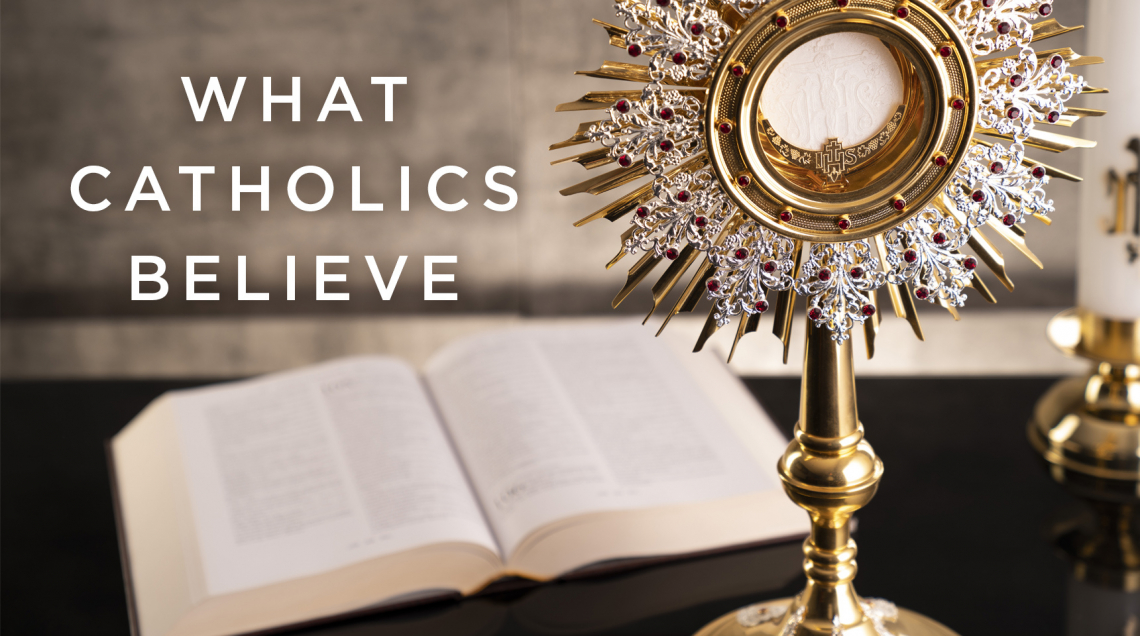The Mass: Lift Up Your Hearts

Now we come to the center point of the celebration of Mass, the Eucharistic Prayer. Of all the actions taking place during Mass, this is the reason why we have come together. It is always possible to hear God’s word proclaimed in other settings. It is always possible to hear a sermon preached apart from Mass. It is sometimes the case that holy Communion is received apart from Mass. But it is not possible to participate in the Eucharistic Prayer at any other time or during any other circumstances than during the celebration of Mass. This is why we come to Mass: in order to join the priest in offering the Eucharistic Prayer to God the Father, through the mediation of Jesus our High Priest, in the power of the Holy Spirit.
That means we have to make the effort to join the priest in offering the prayer to God. And so, we have to discipline ourselves not to let our minds wander during the time that the priest is voicing the Eucharistic Prayer. This can be difficult, since the Eucharistic Prayers are longer than any other prayers at Mass. The priest’s voice alone is heard most of the time, and that can be monotonous to the ear. But each of us has our own part to play as the priest is praying on our behalf to God.
Our first responsibility is to respond to the priest. He says to us, “The Lord be with you,” and “Lift up your hearts,” and “Let us give thanks to the Lord our God.” Each time the priest speaks to us, we have a response to give him in return. We should think about the words we say, “And with your spirit,” “We lift them up to the Lord,” and “It is right and just.” We recognize that God will act through the words and actions of the priest. With him, we lift our minds and hearts to God in gratitude and thanksgiving. We know that we will soon encounter God in person in what is about to happen through the ministry of the priest.
Then the priest proceeds to tell God the reasons why we are giving Him thanks on this particular occasion. This part of the Eucharistic Prayer is called the preface. The preface, which comes between the introductory dialogue of the Eucharistic Prayer and the Holy, Holy, is often specific to the occasion. For example, on Christmas, we give thanks to God because the Son of God became a human being in our flesh. On Easter, we give thanks to God for the resurrection of Jesus. The same is true for the various seasons and feasts of the liturgical year.
The preface always concludes with the reminder by the priest that we on earth are literally joining the angels in heaven in their continuous praise of God. Then, all of us, priest and people together, sing what the angels sang around God’s throne in heaven in the vision of the prophet Isaiah: “Holy, Holy, Holy, Lord God of hosts ...” (Is 6:3). This quotation from the Book of the Prophet Isaiah entered Christian worship from daily Jewish prayers at a very early stage, probably by the year 200 A.D. The repetition of the word “holy” three times is thought to refer to the three persons of the Blessed Trinity who are worshiped both by the angels in heaven and by us on earth.
The second part of our sung acclamation refers to Christ alone, “Blessed is He who comes in the Name of the Lord” (Mt 21:9). This is what the crowds sang when Jesus entered Jerusalem on Palm Sunday. This acclamation is itself a citation of Psalm 118:26, which refers to the coming of the Messiah. We sing these words because Jesus Himself is about to become present to us in His body and blood through God’s action during the Eucharistic Prayer. Jesus will come to us in person like He came to the people of Jerusalem on that original Palm Sunday.
Both parts to the Holy, Holy appear to have become a regular feature of the celebration of Mass in Rome by the years 400 to 450 A.D. Today, all the Christian churches of the East and West, both Catholic and non-Catholic, include the Holy, Holy in their celebrations of the Eucharist.
After singing the Holy, Holy, our posture changes. We have been standing until then. We now kneel for the next portion of the Eucharistic Prayer. Although our posture changes, we continue to pray the same prayer with the priest. The Eucharistic Prayer, which began with the preface dialogue between the priest and us, continues toward its most sacred actions. In preparation for those moments, we kneel in a spirit of humility and adoration. While we kneel, we should continue to pay attention to the words spoken by the priest. We want to lift our minds and hearts in silent prayer to God with the same thoughts the priest is voicing out loud on our behalf.
In the next column, we will explore the different parts of the Eucharistic Prayers and how we can best pray them along with the priest.










